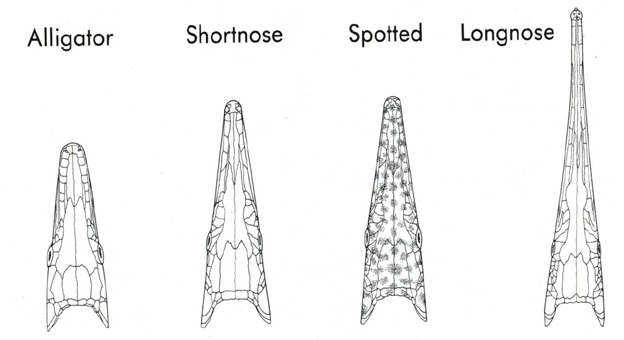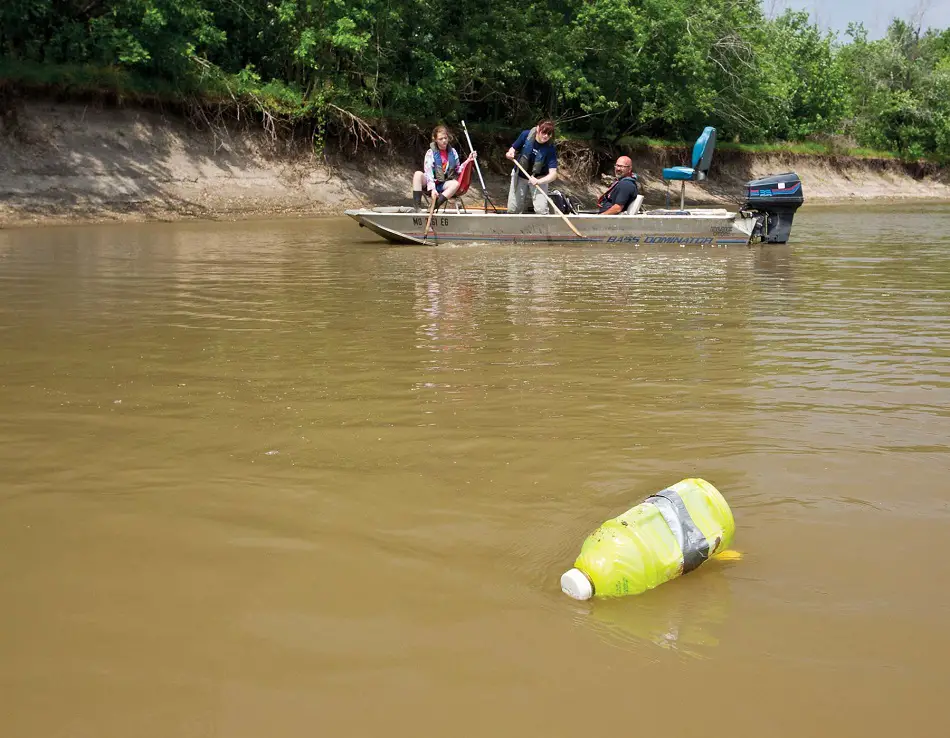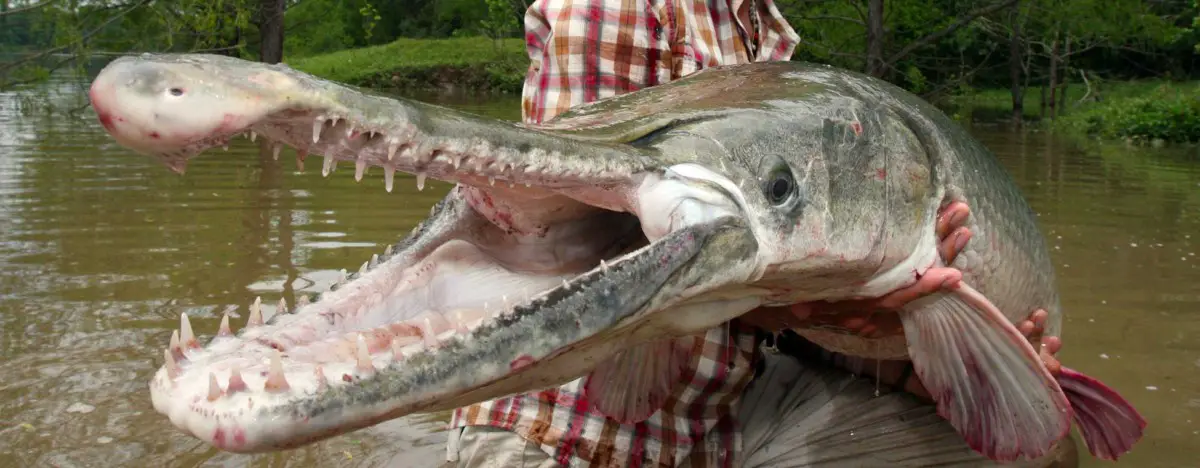If you are down Southern US and hook a Gar Fish you’ll know exactly what it is even if you’ve never seen one before because it’s straight out of Jurassic Park’s fierce-looking body and character that have lately been what anglers are searching for. How do you Catch a Gar Fish?
- Fish the summer months
- Near-surface
- At dawn & dusk
- Use Topwater Plugs
- Live Bait use 4-6″ shiners on 5/0 to 6/0 treble hook-tied 6″ below an orange 4″ bobber.
- Use a Snare or frayed Rope Technique
- Use a Jugging Technique-use empty Jugs on Trotline with 1-2′ metal leaders-large treble hooks & Mullet as Bait
Being from Pennsylvania I had heard about Gar as I traveled down in Southern Georgia and the Florida State Line for Largemouth. When one Alligator Gar approached our canoe as we fished the tree-lined side of a lake we were able to see one in its natural habitat and it was quite a surprise but he was more scared of us than we were of him. I think.
What Is a Gar Fish
The Gar Fish also is known as the Alligator Gar because of its crocodilian head and razor-sharp teeth, it’s easy to see how this giant fish got its name. There are 7 known species of Gar have known to grow up to 10 feet long and as heavy as 350 pounds. This size makes it the biggest freshwater fish in North America. 
The prehistoric relatives of this species first appeared over 15 million years ago and inhabited many parts of the world. Today, Gars live only in parts of Europe, and North and Central America. Alligator gars were historically found throughout the Mississippi River Valley and may have even existed as far north as Iowa and as far west as Kansas and Nebraska.
Today Gars are known only to live in the lower Mississippi River Valley, from Oklahoma to the west, Arkansas to the north, Texas, and portions of Mexico to the south, and east to Florida. Gar can Inhabitat small areas of slow-moving backwaters and swamps along with large lakes, bayous, and Rivers. There are Seven gar species living today, including Alligator, Cuban, Florida, Longnose, Shortnose, Spotted, and Tropical gar. Each species varies in size, color, snout length, and shape.
They come in all sizes can thrive in Fresh or Brackish water and have a diet of blue crabs, turtles, waterfowl or other birds, and even small mammals. They are known as voracious predators hiding and then striking their prey.
There are reasons they have been around and so on. They are built for survival. They have the ability to gulp fresh air during low oxygen conditions, breathing for up to two hours living on land. Another reason is that their relatively large, yolk-filled, greenish eggs are highly toxic to prospective predators. The eggs are laid in shallows in the Spring.
The hatchlings grow remarkably fast, feeding on the start of the hatchlings of other fish and even minnows, and in little time become the voracious predators that their previous generation.
 The 7 species of Gar have a savage-looking collection of teeth, which they use to grab and manipulate prey as it feeds. A double row of teeth on the upper bill distinguishes the alligator gar from other members of the species.
The 7 species of Gar have a savage-looking collection of teeth, which they use to grab and manipulate prey as it feeds. A double row of teeth on the upper bill distinguishes the alligator gar from other members of the species.
They have armor-type scales that form a shell on the outside of their long-beaked body and are able to move their head much the way an alligator can, spinning their body and rolling it around when it’s in danger of being caught.
Gars have elongated bodies and unsymmetrical tails and are covered by overlapping thick scales that can protect them. The alligator gar is dark olive-green dorsally, fading to yellowish-white centrally. Gars are slow-growing fish, with female alligator Gars that can live more than 50 years, reaching sexual maturity around the age of 11. Male alligator Gars mature around age 6 and live at least 26 years. They have a few natural predators.
Where Are Alligator Gar Found
The Alligator Gar Fish along with the other types of Gar species has been commercially fished down in the Southern states for quite a while. It is not classified as a sport fish in most states but is protected wildlife and is considered important in the Southern ecosystem as in Alabama where a 2 per/day limit means there is no Gar Commercial fishing Industry.
The Alligator Gar is rare, endangered, and studied in its local habitat. Studies in Alabama, Mississippi, and Louisiana have shown that the Alligator Gar is very susceptible to overfishing. It has been classified as rare in Missouri, threatened in Illinois, endangered in Arkansas, and Kentucky, and is soon to be in Tennessee.
Across North America, They are often considered among the “Trash Fish” even though they have been added in some lower states as on the protective and endangered list. This has been due to its trophy-size stature and popularity among newbies like me that find them dangerous and interesting. Gars like other trophy fish have a slimy layer of mucus that provides another way for these prehistoric fish to survive but also smell. They are Bad Ass looking for sure!
Gars are ambush predators, they lay still in the water until an unsuspecting fish swims by, and then lunge forward and lash its head from side to side in order to capture prey. Many times gars will lay still at the top of the water for long periods of time, appearing to be merely a log. Adult fish feed primarily on fish but have been found to also consume blue crabs, birds, reptiles, amphibians, and small mammals. They are frequently observed surfacing for air. The reason for this is uncertain. They are commonly heard and seen blowing bubbles and making gulping sounds in concert with other alligator gar suggesting possible communication.
They have a bad reputation as monster-looking fish that won’t put up a fight that the angler is anticipating. The truth is apparently that Gar does everything expected of a Big Predator that refuses to give up and with their size roll and simulates Alligator death-roll.
Are Gar Edible
Recently I spent time in the Southern area of the State and close to the Florida line. I was able to try some and found that it tasted like Alligator. They have a firm thick white meat that was pretty good. (I didn’t cook it) my neighbor from that area did. He also explained the pass-down family recipes he used for Gar Fish and old-fashioned ways of catching them.
If you have ever been down South and seen a Gar Fish you would be noticeably impressed by the awesome stature and presence that Gars have in the water. I have seen them in southern Georgia and had no desire to try and catch one. I’m from Pennsylvania and went to Georgia for largemouth where I caught my fill and decided to inquire from one of the locals about what he was doing tying jugs together on a stringer across the shallow end of the lake.
He said “Gaaaaaa..” with his Southern Georgia accent, and I said “whuut” with my Philly accent and he said ” Gaaaa”. “Juggin fer Gar…..”
Jug Fishing for Gar
The most common and simplest technique, similar to the one that catfish anglers down in the South employ is rigging up lines with minimal effort, called “jugging.” Basically, in jugging, you line up empty milk cartons or anything that floats like Bleach plastic bottles or 2-liter Coke bottles, and rig up a baited hook underneath each jug. Then, you can sit back and relax while you watch  and wait for a bite.
and wait for a bite.
- The water is normally slow and murky with no tide or current to move the jugs around.
- Use the biggest treble hook you can find up to 1-1/2″ to 2″ in diameter.
- Then put a steel leader on the hook-normally 2′-3′ long, they must be that long because the fish actually swallows the hook and you have to recover it when you clean it.
- To the steel leader tie nylon string, the kind used for trotlines, as long as you want, depending on how deep you want to fish.
- Then tie some sort of sealed jug like a Bleach or a 2 liter Cola plastic bottle to the nylon string to act as afloat.
- The Bait will depend on the area, the whole mullet works well.
- Once baited up, throw the jug line in the water and set back & have a cold drink.
- When the jug starts moving it’s FISH ON!
Gar Fishing Rigs
Hooks
Gar has a thin amount of flesh in their mouth, making hookups with large single hooks difficult.
- Use a Small sharp treble hook that will penetrate faster and the number of hook points to increase your chance of a good set.
- Lip hook a baitfish with a #6 to #2 treble hook on a set or float rig. Gar often grabs the bait sideways and slowly swims off.
- Wait until the fish stops and starts to swallow the bait. When he starts to run again, set the hook firmly. Quick-strike rigs and lures with multiple treble hooks increase your chance of a hookup without risking injury caused by swallowed hooks.
- Fish them at different depths from 2′ to 10′ depending on the location.
- To subdue a big gar, 20 pounds or more, it’s imperative to use a heavy tackle: 30- to 80-pound test line, a stout rod, and a sturdy reel with an excellent drag.
Snares
Wire snares like those used to catch rabbits may be the most effective Gar rig that you can use.
- Make a snare by wrapping one end of a 2- 3-foot piece of stainless steel wire around a heavy barrel swivel.
- Run the free end of the wire through the back of a lively baitfish, just below the dorsal fin.
- Swing the free end back toward the swivel and form a loose loop that slides easily on the leader.
- Tie your main line to the swivel and cast the rig onto a shallow flat.
- When a Gar grabs the bait, a firm pull will tighten the snare around its beak.
Ropes
Versatile lures and flies also can be fashioned from strands of frayed nylon rope.
- Cut a 3- to 6-inch piece of 3/8-inch nylon rope, and thread it onto the shank of a hook, jighead, or spinnerbait as you would a plastic worm.
- Use a lighter flame to fuse the rope to the hook shank, then wrap over the melted rope with a strong thread or braided line.
- Cover the thread wraps
Best Time of Year to Catch Alligator Gar
The hot summer months serve up Alligator Gar fishing at its finest. In good waters, you’ll have little trouble finding the Garfish. The biggest and badest Gar is the trophy size Alligator Gar. They’re usually rolling noisily near the surface, especially near dawn and dusk and at night. A lung-like air bladder allows them to gulp air to aid the gills in breathing. Most serious gar anglers also use several feet of steel leader as insurance against the gar’s sharp teeth and violent thrashing.
Like with most predator fish, fishing top-water can be an exhilarating way to go. Especially on the edge of the lake in shallow water with the huge size of a Gar Fish. On a sunny spot on the lake surface, an angler will see a Gar rise up to the top surface:
- Casts a baitfish-imitation plug a few in front of it
- Allow the lure to remain motionless except for an occasional twitch.
- If the Alligator Gar is feeding the fish will soon propel itself toward the bait with a furtive flick of its fins.
- There will be no headlong dash for the plug as you might expect. Instead, the Gar will move very slowly, thinking of itself disguised as a stick or log.
- The Gar will remain stock-still so long as the lure remains motionless.
- Give the lure a tiny wiggle
- The Alligator Gar will rush for it jerking his head to the side of the prey taking air
Do not move the lure at all when you see the gar swimming toward it. If the bait remains still, the gar will swim forward until the lure is alongside and very near its head.
JimGalloway
References: Rigs & Tactics for Gar
Trash Fish Tuesday: Gar article from Meat Eater


